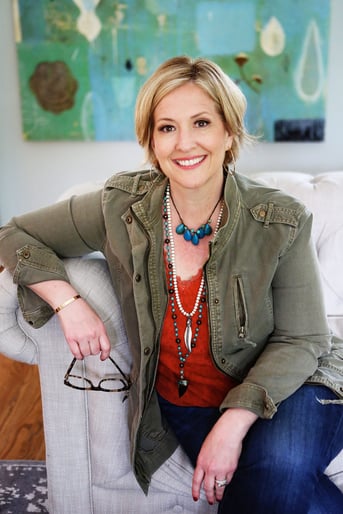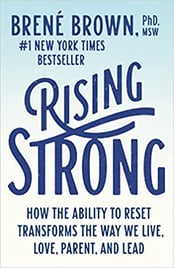Applying Brene Brown’s Rising Strong to Autism
Building Awareness and Theory of Mind
Brene Brown’s illuminating 2015 book, Rising Strong, shows how part of life is handling unexpected situations and dealing with expectations, failures, or disappointments—and finding ways to adjust and cope in spite of struggles. But the goal is not simply to survive and live another day, but to thrive. With unknowns and stressors on nearly every front nowadays, we could all use lessons on how to be a reflective self-advocate.
Who is Brene Brown?
 A qualitative research professor at the University of Houston, Brown spent the last two decades researching courage, vulnerability, shame, and empathy. She’s authored six New York Times bestsellers, given multiple Ted Talks, and continues to host several podcasts to dig deeper into the implications and application of these themes.
A qualitative research professor at the University of Houston, Brown spent the last two decades researching courage, vulnerability, shame, and empathy. She’s authored six New York Times bestsellers, given multiple Ted Talks, and continues to host several podcasts to dig deeper into the implications and application of these themes.
The Rising Strong Model
Brown’s interviews found that those better equipped to handle the challenges life throws at them tend to cope using a similar 3-step pattern. This process can occur after a big event, like the death of someone, or simply after a colleague’s comment.
Step One: The Reckoning
This is when you acknowledge and deal with emotions instead of ignoring them. Like many processes, validating those feelings as real and present is the first step in regulating and making sense of things. Especially after you’ve had a few reckonings, you can start to look for patterns in yourself to help you recognize these emotions.
It might be that I know my triggers. I know that every time this relative begins with, “Well you should really…” I feel my stomach tighten and immediately tune out any words that follow. It could be that whenever I drive by my first house, I get teary and quiet. Being in tune with your body and paying attention to triggers for those reactions helps make sense of those feelings.
-
How this can apply to individuals with autism spectrum disorder (ASD):
Some of Kelly Maher’s work and teaching resources on “the eighth sense,” interoception might show the way. If you haven’t heard of it, here is Kelly giving a quick run-down of how interoception works. Interoception can help those with ASD start to understand how the inside of our bodies communicates needs and feelings. If I start to feel and hear a grumble in my stomach, I’m hungry. If I start to feel light-headed, dizzy, or have no appetite, I might be feeling nervous or overwhelmed. Gaining a greater understanding of these physical, internal experiences can help people with ASD make sense of their emotions—“Oh, when my palms start to get sweaty, it means I’m anxious.”
Step Two: The Rumble
This is the step when we confront the stories we make up about ourselves through the struggle. A lot of times when we have disappointments, failures, or losses we tell ourselves a story like, “I’m not good enough, smart enough, pretty enough, strong enough, etc.” Sometimes the stories we tell ourselves can be deeply engrained from societal pressures or things we’ve had said to us in the past. Brown suggests writing these perceptions down in what she calls a “Shitty First Draft” or “SFD.” Like all first drafts, it’s usually not very good or an accurate picture of the situation, but making the draft is necessary to understand the situation.
-
How this can apply to individuals with ASD:
This step in the process can help develop our Theory of Mind (ToM). ToM is basically perspective taking or some autism instructional supports will call it “mind reading.” Understanding other people’s feelings and motivations can be a particular challenge for people with ASD. Actually writing down an SFD, recording one, or drawing pictures could all be great jumping-off points for those with ASD to start digging deeper into their own perceptions and fill in the gaps where things aren’t making sense. This could also be a helpful processing tool for individuals to take to a trusted friend or adult to process and discuss if they aren’t able to work through what the other person might have meant or intended through a conflict that occurred.
Step Three: The Revolution
This is the application part of the process. Now that we’ve grappled with our SFD, it’s time to write a new ending to the story. This is where we get curious about other people’s motivations and our own insecurities, and let people know where we’re at. Brown empowers readers to use our SFD to gain self-awareness and to advocate by being vulnerable and using the language “the story I’m telling myself...” as we work through conflicts that arise in our lives.
-
How this can apply to individuals with ASD:
What I love most about The Revolution is that Brown includes a script on how to start the conversation when advocating for yourself and navigating tricky conversations. Once you’ve worked through your SFD and understood the situation and your feelings better, you can follow up with the individuals involved. You can start with, “The story I was telling myself was that you didn’t think my work was good enough.” Or, “The story I was telling myself was that you didn’t pick me as a partner because you don’t like me.” Or whatever the story is! Being open, honest, and vulnerable can allow individuals with ASD to gain greater awareness of social situations, build relationships with others, and advocate for what they need.
SFD and understood the situation and your feelings better, you can follow up with the individuals involved. You can start with, “The story I was telling myself was that you didn’t think my work was good enough.” Or, “The story I was telling myself was that you didn’t pick me as a partner because you don’t like me.” Or whatever the story is! Being open, honest, and vulnerable can allow individuals with ASD to gain greater awareness of social situations, build relationships with others, and advocate for what they need.
Of course, the process for Rising Strong is never a straight line and some of these steps could take years or months—but maybe just minutes. The point is to continue to strive, to understand yourself and others better while thriving in the face of adversity.
What are some ways you think the Rising Strong model could be helpful for an individual with ASD, or for a parent or teacher?
We hope you enjoyed the information in this article. STAGES® Learning also offers free downloadable resources to support teaching and learning with individuals with autism. Start with our free Picture Noun Cards and see our collection of other downloadable resources here!
References:

Frankie Kietzman, Ed.S.
Frankie Kietzman is a Sales Development Associate for STAGES Learning with experience teaching as an elementary teacher, self-contained autism teacher for elementary and secondary students, autism specialist and coach for teachers dealing with challenging behaviors. Frankie’s passion for supporting children and adults with autism originates from growing up with her brother who is deaf and has autism. As one of her brother’s legal guardians, she continues to learn about post-graduate opportunities and outcomes for people with autism. Frankie has a Bachelor’s degree from Kansas State University in Elementary Education, a Master’s degree in high and low incidence disabilities from Pittsburg State University and in 2021, completed another Master’s degree in Advanced Leadership in Special Education from Pittsburg State University.



